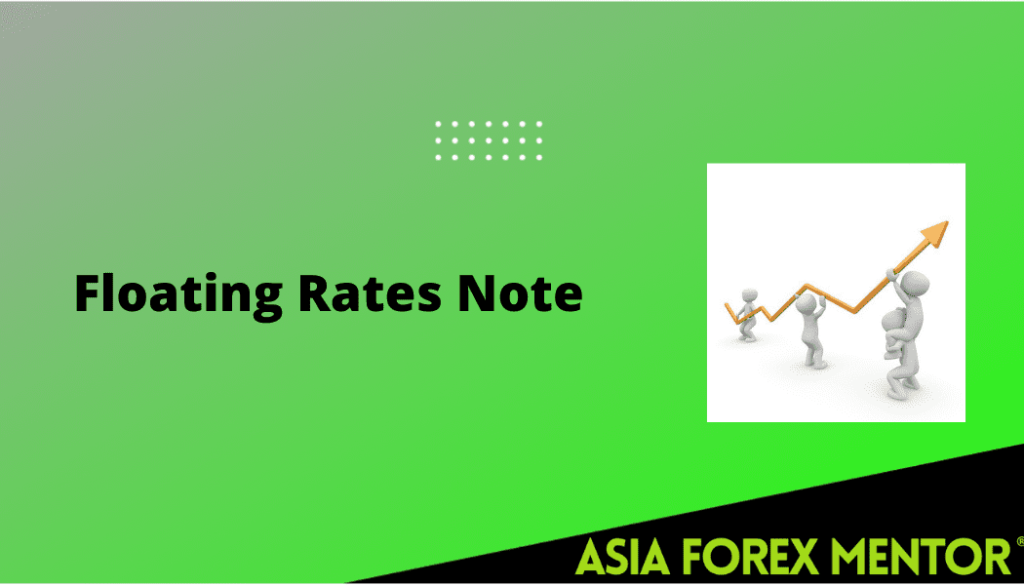
Also Read: Floating Exchange Rate: A Complete Guide

Contents
- What is a Floating Rate Note?
- Can Floating Rate Notes Safeguard Against High-Interest Rates?
- How Does a Floating Rate Note Pay Out?
- Should You Invest in Floating or Fixed Income Securities?
- Does Investing in FRNs Protect You from Interest Rate Risk?
- Types of FRNs
- What are the Advantages and Disadvantages of Callable FRNs?
- FAQs
What is a Floating Rate Note?
Corporate bonds with variable coupon rates pegged to a short-term benchmark interest rate are known as floating rate notes, or FRNs.
Typically, a supplementary yield is added to the reference rate to reimburse investors for the liabilities associated with lending to an entity, namely the possibility that it would default and fail to make regular debt payments.
Because they are issued by firms with investment-grade ratings, the margin between the reference rate and the variable rate note yield is often between 25 and 100 basis points.
Traditionally, FRNs were pegged to the three-month London Interbank Offered Rate (LIBOR), but this rate is being phased out. Recent floating rate note offerings often use the Secured Overnight Financing Rate (SOFR) as their reference rate.
But the rates that support them are usually short-term rates that are closely related to the federal funds rate.

Can Floating Rate Notes Safeguard Against High-Interest Rates?
In an environment of increasing rates, there is no assurance that the rate of a floating rate note would increase at the same pace as the interest rate.
In this case, the interest payments would be dependent on the coupon rate, which will be higher if market rates rise.
So, a person who owns a note with a variable rate could still be at risk of interest rate risk, which happens when the bond's rate does poorly compared to the market as a whole.
Because the bond's rate may be adjusted in response to market circumstances, a floating rate note's valuation manages to be less volatile and subject to fewer changes in price.
When rates go up, the value of conventional fixed-rate bonds often declines because current bondholders incur a loss by retaining a product yielding a lower rate.
FRNs reduce market price fluctuations because borrowers incur lower opportunity costs with market conditions of rising rates.
Just like any bond, a floating rate note is subject to the risk of default, which happens when the firm or government is unable to repay the principal or initial investment amount.

How Does a Floating Rate Note Pay Out?
As FRNs have fluctuating rates, payments are often uncertain. A coupon payment is the bond's return payout.
Occasionally, a floating rate note may include a cap and a floor, allowing investors to determine the note's highest and lowest bond yields.
The payout on a floating rate note can fluctuate as often as the seller chooses.
The rollback period, which is detailed in the bond's paperwork, informs the buyer of the rate's resetting frequency.
Earnings may be paid every month, quarter, half-yearly, or annually by the issuer.
Should You Invest in Floating or Fixed Income Securities?
When a buyer anticipates the reference interest rate rising shortly, he or she may acquire a floating rate note.
In the event of a rate hike, a floating rate note has an advantage over conventional bonds.
The relationship between regular bond prices and their estimated return yield is inverse.
The value of conventional bonds decreases as the interest rate rises, and the longer the tenure of the bond, the higher the value losses.
Nevertheless, the value of the note with a variable interest rate does not decrease when there is a rise in the interest rate.
Adjustments to the variable rate note's interest rate assist in preserving its value.
Does Investing in FRNs Protect You from Interest Rate Risk?
Generally, a floating rate note, particularly one offered by a government agency, is seen as a secure investment.
Nonetheless, a prospective buyer of such debt instruments must be aware of certain pitfalls.
Notes with a variable interest rate may be subject to credit risk and default risk.
Since both the government and private businesses can issue a floating rate note, a smart investor will carefully look into how trustworthy the issuer is.
Floating rate note coupon payouts are tied to a benchmark interest rate, so they profit from a rise in interest rates.
But they are not entirely protected against interest rate risk since there are several reference rates, while a variable rate note is normally tied to just one.
Also Read: What Is Risk Reversal
Types of FRNs
Floored Floating Rate Note
Floored FRNs offer holders a minimum payout if yields remain low.
An investor gets payments equal to the larger of the benchmark interest rate and the lowest return with a floored rate.
The owner would get a coupon equal to the coupon floor if the benchmark interest rate is less than the coupon floor.
If the benchmark interest rate is higher than the coupon minimum, the investor will get the benchmark interest rate.
Capped Floating Rate Note
The holder of a capped FRN receives the benchmark rate up to a specified, capped rate.
When the benchmark rate exceeds the limit, the negotiated highest amount is paid to the investor instead of the benchmark rate.
Callable Capped Floating Rate Note
Callable capped FRNs let the holder redeem the notes at face value at a preset date.
If the benchmark rate stays below the limit and the note is not called, callable capped FRNs surpass non-callable capped FRNs.
Collared Floating Rate Note
Collared FRNs provide an upper and lower limit coupon payment for the duration of the note.
When the benchmark rate falls below the floor rate, the owner gets the coupon payment that is floored.
The investor gets the capped rate if the benchmark rate climbs above the capped rate for that time.
The buyer gets the benchmark rate when it falls between the cap and floor.
Fixed to Floating Rate Note
These notes have a fixed rate for the first period and a variable rate for the remainder of their term.
If the reference rate is lower than the maximum coupon, the coupon payments on the note are set up to pay a higher coupon.
What are the Advantages and Disadvantages of Callable FRNs?
FRNs can be offered with or without the ability to call, which allows the seller to refund the investor's capital and cease paying interest.
The callable feature is known ahead of time, and it lets the bond issuer buy back the bond before it matures.
Advantages
A callable floating rate note is less susceptible to price fluctuation and can be used to take advantage of a rising rate environment.
FRNs exist for U.S. Treasuries and commercial bonds, both of which have a proven track record of prompt interest payment, so the risk is lower than other comparable fixed-rate counterparts.
Disadvantages
Floating rate securities can still be subject to interest rate risk if market rates increase more than the coupon rate.
FRNs may be susceptible to default risk if financial institutions are unable to repay the coupon rate due to rising interest rates that far exceed the interest income.
If market rates fall, FRN payment rates may also decline. In general, FRNs carry a lower interest rate than their fixed-rate equivalents.
FAQs
What are FRNs?
A floating rate note is a fixed-income instrument that pays a coupon based on a regularly changing rate.
As the rate varies, the realized amount also varies over time. When buyers think that interest rates will go up, there is a lot of demand for notes with rates that change over time.
What are the advantages of investing in FRNs?
Investing in FRNs is advantageous because they allow investors to receive bigger coupon payments if the benchmark rate rises.
A floating rate note has a shorter lifetime than a fixed-rate note, which preserves its value in a climate of increasing interest rates.
What are the dangers associated with purchasing FRNs?
Floating-rate notes can turn into liabilities if interest rates fall, resulting in fewer coupon payments. All payments on variable rate notes are contingent on the entity's creditworthiness.

















